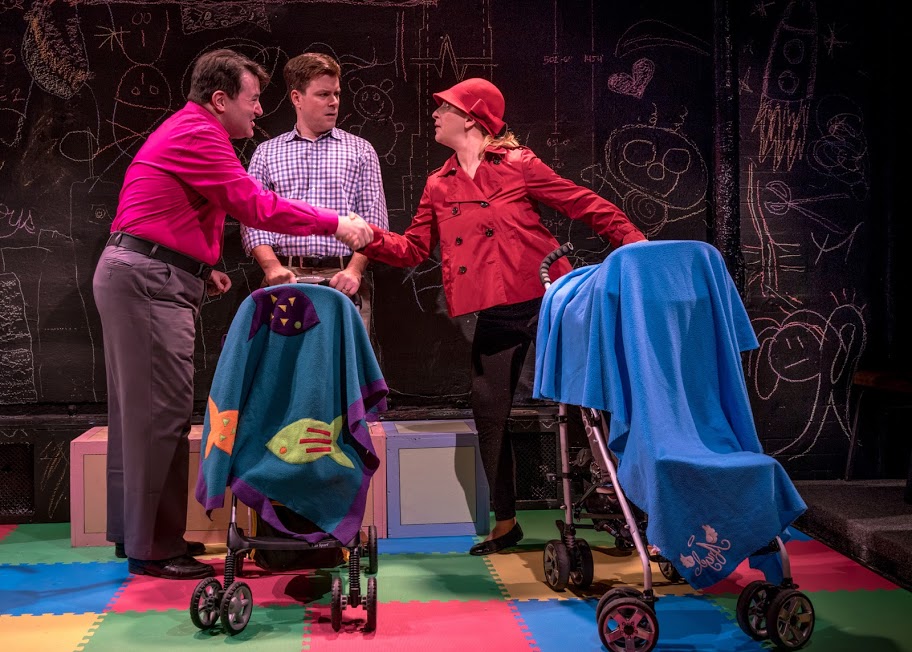By Samuel L. Leiter
The three-quarter round Mitzi E. Newhouse Theatre has been turned by designer Nick Vaughan into a pit-like, wood-paneled boxing arena for The Royale, Marco Ramirez’s (TV’s “Orange is the New Black”) KO of a boxing play about the attempt by an early 20th-century “Negro Heavyweight Champion of the World” to eliminate the word “Negro” from that title by defeating the white champion. The Royale is loosely based on the experiences of Jack Johnson, the pre-Civil Rights black fighter who inspired Howard Sackler’s Tony- and Pulitzer-winning 1967 play, The Great White Hope; more compactly constructed than Sackler’s drama, it shifts the focus from the boxer’s affair with a white woman to his fierce desire to lure the retired white champ back into the ring.
Staged with thrilling, even ritualized theatricality by the exceptional young director Rachel Chavkin (Natasha, Pierre and the Great Comet of 1812), the 75-minute, “six-round” play (originally staged by her in Los Angeles in 2013) lands blow after blow through its pounding, semi-poetic dialogue; powerful, rhythmic handclapping; shouted exclamations of “Ooh!”; and the persistent crash on a slatted wooden floor of boxing ring rope posts. At key moments, a ringside bell punctuates the proceedings. Brilliant choreography has been applied to the fight sequences, with the impact of punches landed created by loudly resonant stamping. A pulsating rhythm infects the acting, both inside and outside the ring, much of it involving carefully patterned movements.
Ramirez is more interested in making his hard-hitting points than replicating historical accuracy. The fights, for example, are staged with bare knuckles wrapped in tape, even though the action is set during the last century’s first decade; under the Marquess of Queensberry rules, gloveless fighting disappeared in the late 19th century. And the frequent references to radio broadcasts are also anachronistic since commercial broadcasting didn’t begin until 1920-1921.
The action keeps bobbing, weaving, jabbing, and swinging, landing one potent blow after the other as it tells of the charismatic Jay “Sport” Jackson (Khris Davis), a figure as verbally colorful as Muhammad Ali, who strives to get white champion Bernard Bixby, based on James J. Jeffries, to meet him in the ring for a championship bout. In Jay’s corner are his brash, self-serving white manager, Max (John Lavelle, who also plays a referee and several reporters); a promising black fighter, Fish (McKinley Belcher III), who becomes his sparring partner; and Wynton (Clarke Peters), his trainer, who tells a story explaining what “The Royale” actually means.
Bixby, whom we never see, eventually agrees to the match, but only if he gets 90 percent of the huge, projected take. Jay’s sister, Nina (Montego Glover), appears, however, and tries to talk Jay out the fight, fearing the enormously negative consequences if a black pugilist bests a white champ. Jay is seriously conflicted but, fueled by his dreams of racial advancement (he’s distressed, for example, that blacks never appear on advertising posters), he forges ahead. When the fight occurs the playwright introduces the striking conceit of having Nina in the ring as Jay’s adversary. The implications of Jay’s dilemma could not be clearer.
There are no false notes in the ensemble, led by the impressively built and completely convincing Davis as Jay and the ferociously determined Glover as Nina. These are award-quality performances. Dede M. Avite’s period costumes contribute nicely, but most impressive is Austin R. Smith’s amazing lighting, accentuating the rhythmic performance with razor-sharp changes, and complementing Chavkin’s poster-like images with just the right old-time ambience.
The Royale may not float like a butterfly but it stings like a bee. It’s bare-knuckled dramatic fisticuffs with a one-two punch that will send you reeling.
The Royale. Through May 1 at the Mitzi E. Newhouse Theatre at Lincoln Center (150 West 65th Street, NYC). 90 minutes, no intermission. www.lct.org
Photos by T. Charles Erickson
























